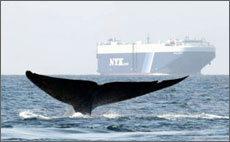 | 
#14 2007
The (Not So) Fast Lane:
Making Small Changes to Vessel Lanes Yields Huge Results
To protect endangered whales in Stellwagen Bank National Marine Sanctuary, researchers from the sanctuary studied whale concentrations and shipping traffic, and discovered that the threat of ship strike was highest in the Boston shipping lanes, which cut through the sanctuary. In collaboration with the U.S. Coast Guard, NOAA partners, and the maritime industry, the researchers proposed narrowing and moving the lanes to areas used less frequently by whales. The proposal was accepted by the International Maritime Organization and went into effect on July 1, 2007. The new lanes reduce the risk of whale strike for all great whales as much as 81 percent.
Shifting shipping lanes can also help protect resources in other sanctuaries. Cordell Bank and Gulf of the Farallones National Marine Sanctuaries worked collaboratively with NOAA, partners, the U.S. Coast Guard, and the maritime industry to recommend lane adjustments to historic traffic lanes into San Francisco Bay to reduce the risk of ships encountering endangered whales. Work is also now underway in the Channel Islands to help reduce ship strike risks to endangered whales, especially blue whales, by proposing an adjustment in the positioning of the ship traffic lanes within the Santa Barbara Channel.
|
|
Designated lanes help keep everyone safe: the large vessels that use them, the smaller vessels around them, and the sea life under them. Smaller recreational craft don't normally need designated lanes, but there's always something new to learn about safe recreational boat operation.

More information about the lane shift in Stellwagen Bank
|
|

